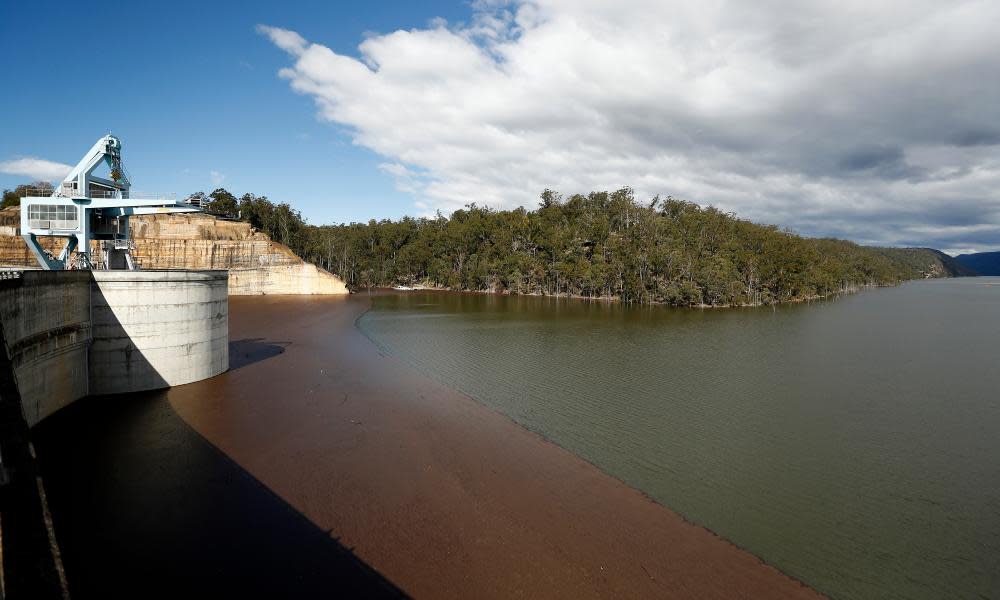NSW government ordered to revisit world heritage assessments for Warragamba Dam expansion

The New South Wales government has been ordered to redo world heritage assessments for its proposed raising of the Warragamba Dam wall after a federal analysis found it had failed to consider the impact on iconic species including the platypus.
A leaked report by federal environment bureaucrats found government agency WaterNSW did not adequately assess how its plan to raise the dam wall by 17m could affect the world heritage values of the Blue Mountains.
The failures included not assessing how flooding or changed hydrology might affect the platypus and echidna, and inadequately examining how the sight of dead trees and shrubs would affect views of the world heritage area from numerous lookout points.
“The proposal has not been adequately assessed for the impacts on the World Heritage Area’s national and world heritage values and outstanding universal values,” officials wrote.
Related: 'Mud and dead trees': the dire environmental effects of raising Warragamba dam wall
The document is the latest in a series of state and federal environmental assessments that have found significant deficiencies in the work carried out by the state government owned water agency.
Officials have already identified failures by WaterNSW to properly assess the impact of the project on threatened wildlife, including the koala, greater glider and regent honeyeater, and Indigenous heritage.
WaterNSW commissioned the consultancy SMEC to conduct its wildlife and heritage surveys.
“If you were going to summarise the advice from all the state bureaucracy and the federal government, it’s ‘Go back and start again’,” said Alec Marr, a veteran conservationist and world heritage expert.
Marr said the failures identified in the environmental impact statement were so broad-ranging they could not be “fixed with a few tweaks”.
“It needs to be fundamentally reformed and a new firm needs to be appointed that’s capable of doing the job,” he said.
In its analysis of the world heritage assessment for the project, the federal environment department found WaterNSW had only considered species listed as threatened under environment laws and not all species that were considered to be attributes of the world heritage area.
The platypus and echidna, which are not currently listed as threatened, fall into this category.
Officials wrote the omission of the platypus was “particularly concerning” because both its food supply and nesting habitat were likely to be affected both upstream and downstream of the project.
The department also found WaterNSW did not properly assess how raising the wall would affect the diversity of eucalypts, one of the outstanding values for which the Blue Mountains world heritage area was declared. Instead, effects on eucalypts had only been considered in terms of the individual species listed as threatened under national law.
“They’re obliged to deal with these outstanding values as specified in the world heritage declaration,” ecologist Steven Douglas said.
“If they don’t, then the federal government couldn’t approve it because it’s not valid. That’s what DAWE (Department of Agriculture, Water and Environment) is saying.”
Other conclusions the department reached were that the project had been inadequately assessed for its effects on:
A recently renamed species of perch, known as the Blue Mountains or Hawkesbury perch.
Aquatic macro-invertebrate populations, which are significant in feeding habitat for the platypus, Blue Mountains perch and other species.
Related: 'So much that will be lost': concerns grow over plan to raise Warragamba dam wall
The views over the world heritage area. The department noted the assessment focused only on the two most frequently visited lookouts and “numerous” less-visited look-out points were omitted. There had also been no assessment of visual impacts from the air for both sight-seeing and commercial flights.
The department added WaterNSW needed to conduct a more comprehensive survey of sacred sites and provide “clear evidence” traditional owners had consented to the project proceeding.
It also said the effect of the project on plants and animals should be reassessed in light of the 2019-20 bushfires.
A spokesman for WaterNSW said surveys had been conducted in line with planning rules listed under the secretary’s environmental assessment requirements for state-significant infrastructure projects.
He said additional studies and information sought by agencies that went beyond those requirements were “part of the process of obtaining feedback” from government agencies and “where appropriate, will be incorporated into the draft EIS”.
“Once that process and any additional studies are complete, the draft environmental assessment will be placed on public exhibition for further community input.”

 Yahoo News
Yahoo News 
